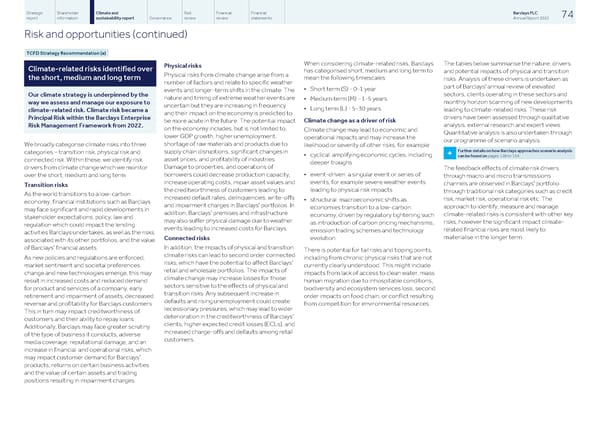Strategic Shareholder Climate and Risk Financial Financial Barclays PLC 74 report information sustainability report Governance review review statements Annual Report 2022 Risk and opportunities (continued) TCFD Strategy Recommendation (a) When considering climate-related risks, Barclays The tables below summarise the nature, drivers Physical risks Climate-related risks identified over has categorised short, medium and long term to and potential impacts of physical and transition Physical risks from climate change arise from a mean the following timescales: the short, medium and long term risks. Analysis of these drivers is undertaken as number of factors and relate to specific weather part of Barclays' annual review of elevated • Short term (S) - 0-1 year events and longer-term shifts in the climate. The sectors, clients operating in these sectors and Our climate strategy is underpinned by the nature and timing of extreme weather events are • Medium term (M) - 1-5 years monthly horizon scanning of new developments way we assess and manage our exposure to uncertain but they are increasing in frequency • Long term (L) - 5-30 years leading to climate-related risks. These risk climate-related risk. Climate risk became a and their impact on the economy is predicted to drivers have been assessed through qualitative Principal Risk within the Barclays Enterprise Climate change as a driver of risk be more acute in the future. The potential impact analysis, external research and expert views. Risk Management Framework from 2022. on the economy includes, but is not limited to, Climate change may lead to economic and Quantitative analysis is also undertaken through lower GDP growth, higher unemployment, operational impacts and may increase the our programme of scenario analysis. shortage of raw materials and products due to We broadly categorise climate risks into three likelihood or severity of other risks, for example: Further details on how Barclays approaches scenario analysis supply chain disruptions, significant changes in categories – transition risk, physical risk and + • cyclical: amplifying economic cycles, including can be found on pages 128 to 134. asset prices, and profitability of industries. connected risk. Within these, we identify risk deeper troughs Damage to properties, and operations of drivers from climate change which we monitor The feedback effects of climate risk drivers • event-driven: a singular event or series of borrowers could decrease production capacity, over the short, medium and long term. through macro and micro transmissions events, for example severe weather events increase operating costs, impair asset values and channels are observed in Barclays' portfolio Transition risks leading to physical risk impacts the creditworthiness of customers leading to through traditional risk categories such as credit As the world transitions to a low-carbon increased default rates, delinquencies, write-offs risk, market risk, operational risk etc. The • structural: macroeconomic shifts as economy, financial institutions such as Barclays and impairment charges in Barclays’ portfolios. In approach to identify, measure and manage economies transition to a low-carbon may face significant and rapid developments in addition, Barclays’ premises and infrastructure climate-related risks is consistent with other key economy, driven by regulatory tightening such stakeholder expectations, policy, law and may also suffer physical damage due to weather risks, however the significant impact climate- as introduction of carbon pricing mechanisms, regulation which could impact the lending events leading to increased costs for Barclays. related financial risks are most likely to emission trading schemes and technology activities Barclays undertakes, as well as the risks materialise in the longer term. evolution. Connected risks associated with its other portfolios, and the value In addition, the impacts of physical and transition of Barclays’ financial assets. There is potential for tail risks and tipping points, climate risks can lead to second order connected including from chronic physical risks that are not As new policies and regulations are enforced, risks, which have the potential to affect Barclays’ currently clearly understood. This might include market sentiment and societal preferences retail and wholesale portfolios. The impacts of impacts from lack of access to clean water, mass change and new technologies emerge, this may climate change may increase losses for those human migration due to inhospitable conditions, result in increased costs and reduced demand sectors sensitive to the effects of physical and biodiversity and ecosystem services loss, second for product and services of a company, early transition risks. Any subsequent increase in order impacts on food chain, or conflict resulting retirement and impairment of assets, decreased defaults and rising unemployment could create from competition for environmental resources. revenue and profitability for Barclays customers. recessionary pressures, which may lead to wider This in turn may impact creditworthiness of deterioration in the creditworthiness of Barclays’ customers and their ability to repay loans. clients, higher expected credit losses (ECLs), and Additionally, Barclays may face greater scrutiny increased charge-offs and defaults among retail of the type of business it conducts, adverse customers. media coverage, reputational damage, and an increase in financial and operational risks, which may impact customer demand for Barclays’ products, returns on certain business activities and the value of certain assets and trading positions resulting in impairment charges.
 Barclays PLC - Annual Report - 2022 Page 75 Page 77
Barclays PLC - Annual Report - 2022 Page 75 Page 77